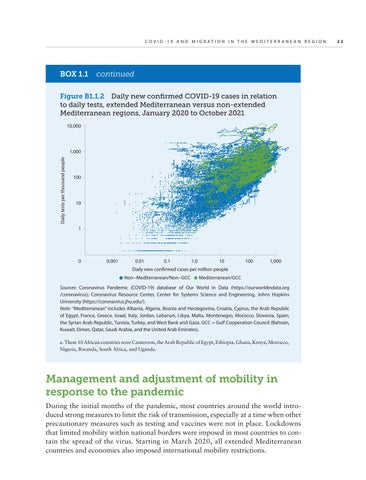C OVID - 1 9 a n d M i g r a t i o n i n t h e M e d i t e r r a n e a n R e g i o n
BOX 1.1 continued Figure B1.1.2 Daily new confirmed COVID-19 cases in relation to daily tests, extended Mediterranean versus non-extended Mediterranean regions, January 2020 to October 2021 10,000
Daily tests per thousand people
1,000
100
10
1
0
0.001
0.01
0.1
1.0
10
100
1,000
Daily new confirmed cases per million people Non−Mediterranean/Non−GCC
Mediterranean/GCC
Sources: Coronavirus Pandemic (COVID-19) database of Our World in Data (https://ourworldindata.org /coronavirus); Coronavirus Resource Center, Center for Systems Science and Engineering, Johns Hopkins University (https://coronavirus.jhu.edu/). Note: “Mediterranean” includes Albania, Algeria, Bosnia and Herzegovina, Croatia, Cyprus, the Arab Republic of Egypt, France, Greece, Israel, Italy, Jordan, Lebanon, Libya, Malta, Montenegro, Morocco, Slovenia, Spain, the Syrian Arab Republic, Tunisia, Turkey, and West Bank and Gaza. GCC = Gulf Cooperation Council (Bahrain, Kuwait, Oman, Qatar, Saudi Arabia, and the United Arab Emirates). a. These 10 African countries were Cameroon, the Arab Republic of Egypt, Ethiopia, Ghana, Kenya, Morocco, Nigeria, Rwanda, South Africa, and Uganda.
Management and adjustment of mobility in response to the pandemic During the initial months of the pandemic, most countries around the world introduced strong measures to limit the risk of transmission, especially at a time when other precautionary measures such as testing and vaccines were not in place. Lockdowns that limited mobility within national borders were imposed in most countries to contain the spread of the virus. Starting in March 2020, all extended Mediterranean countries and economies also imposed international mobility restrictions.
3 3

